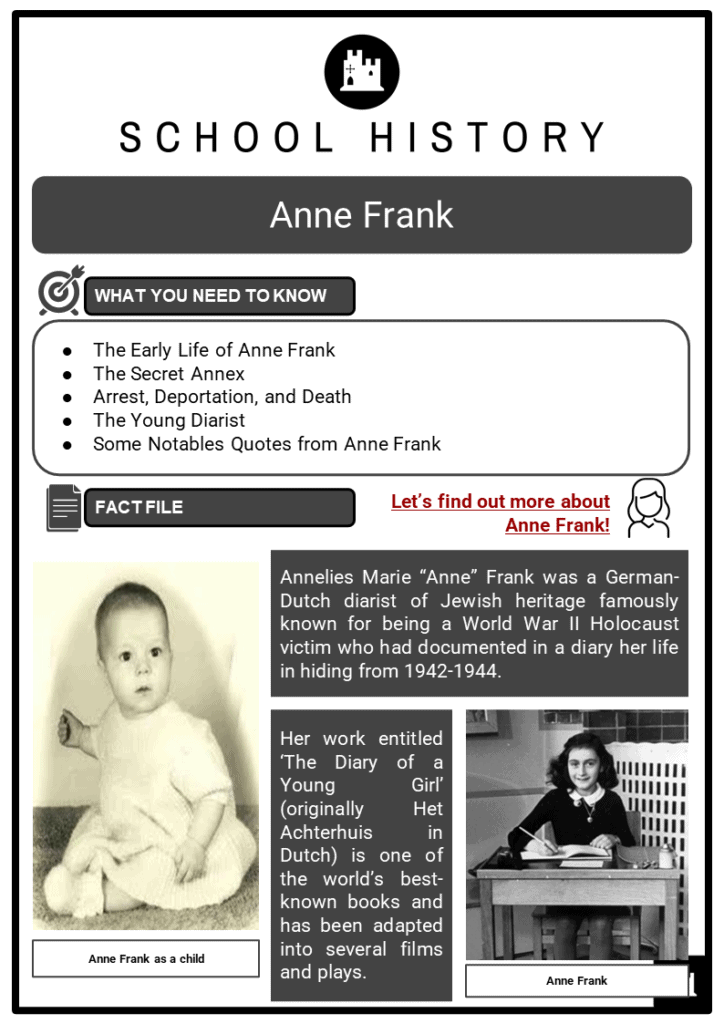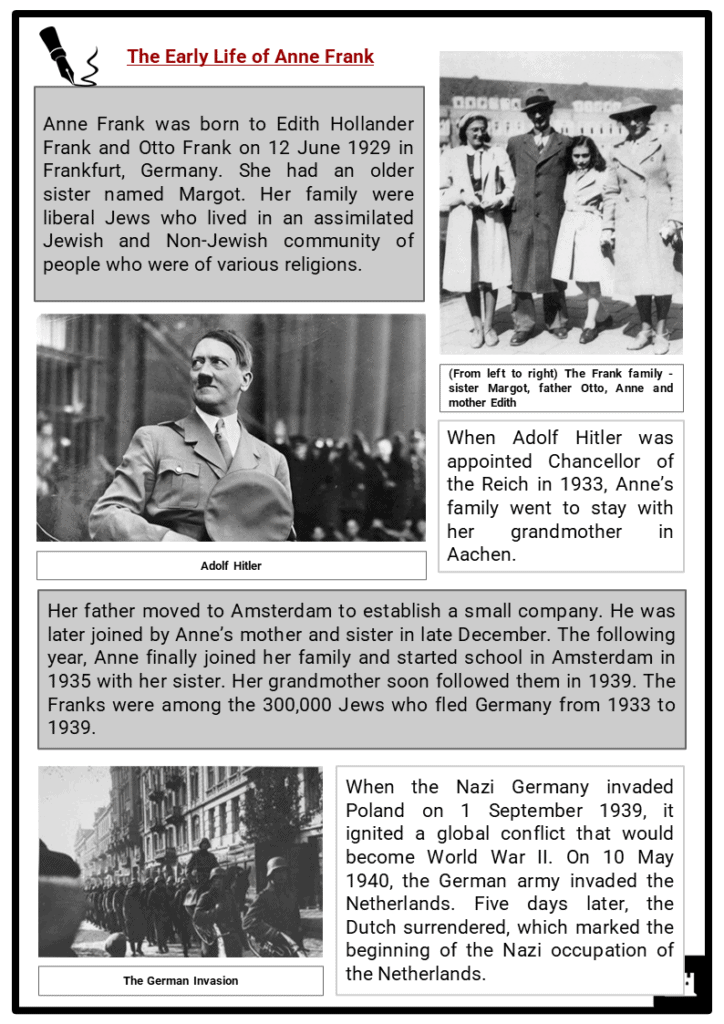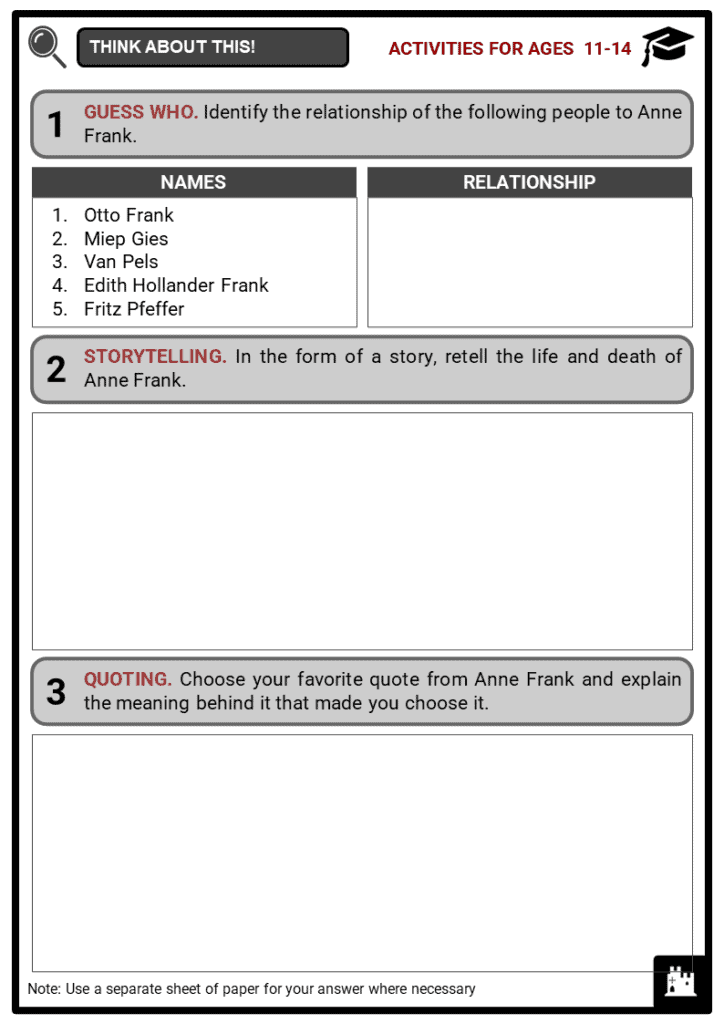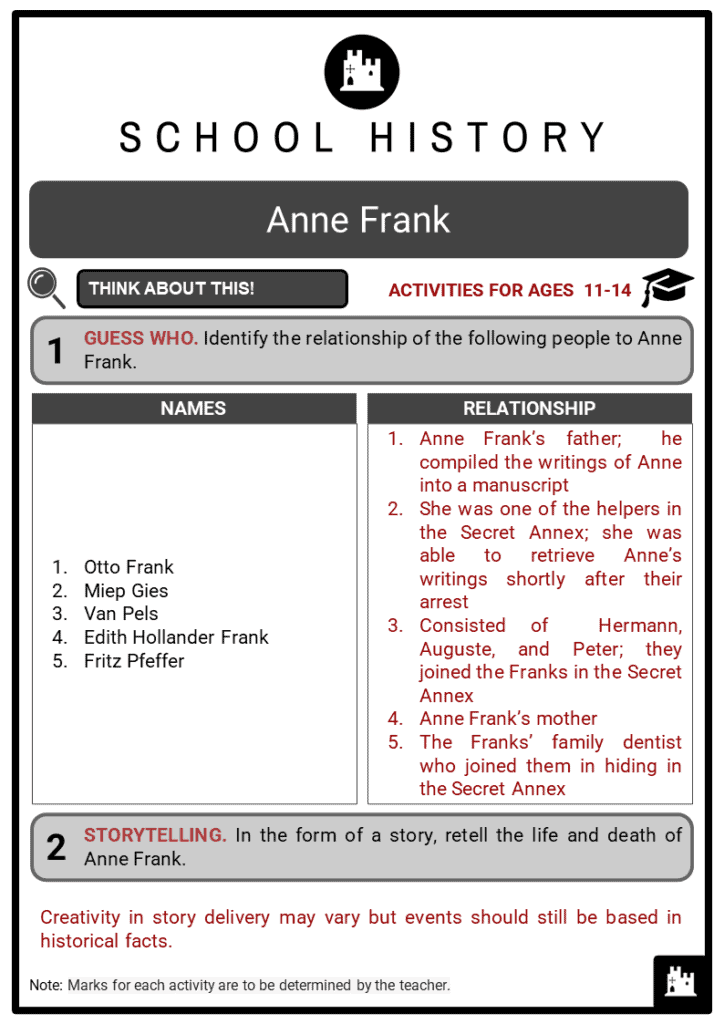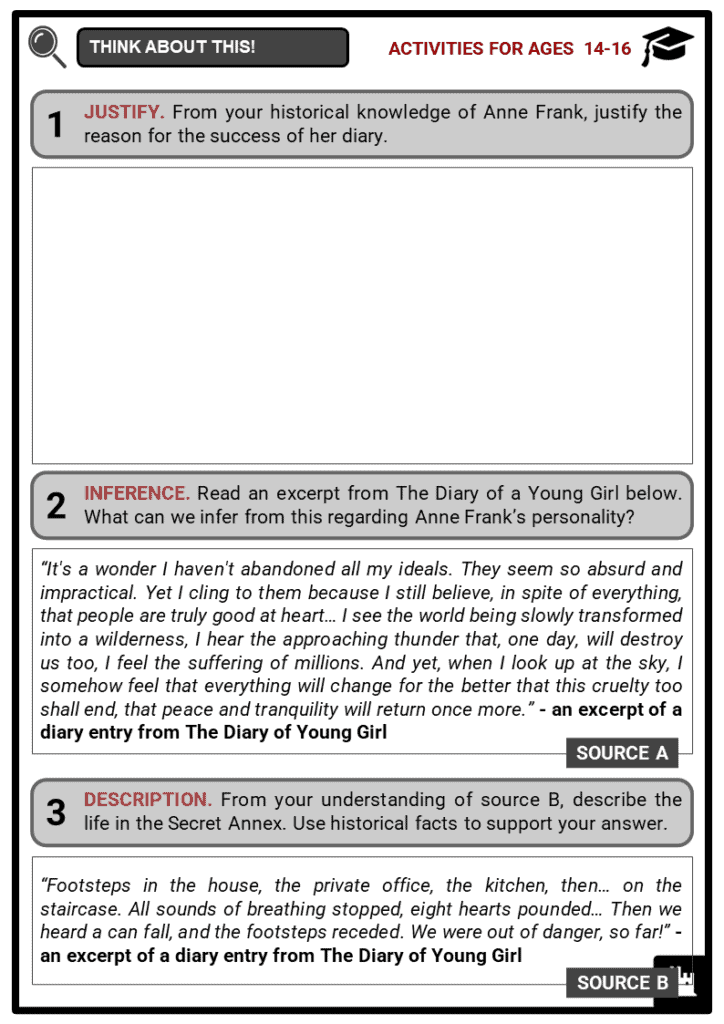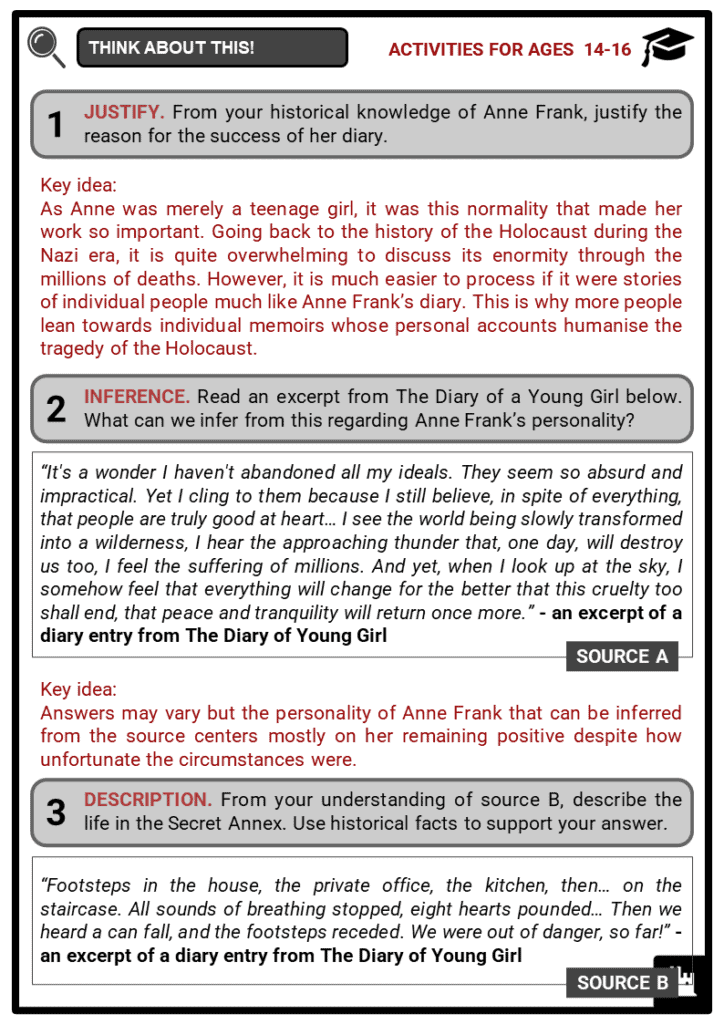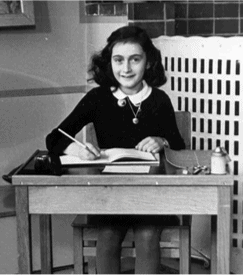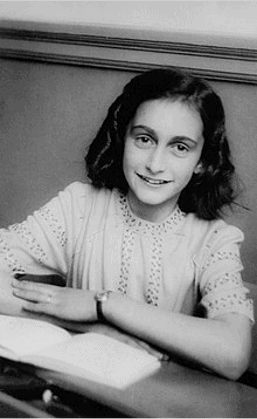Download Anne Frank Worksheets
Do you want to save dozens of hours in time? Get your evenings and weekends back? Be able to teach Anne Frank to your students?
Our worksheet bundle includes a fact file and printable worksheets and student activities. Perfect for both the classroom and homeschooling!
Table of Contents
Add a header to begin generating the table of contents
Summary
- The Early Life of Anne Frank
- The Secret Annex
- Arrest, Deportation, and Death
- The Young Diarist
- Some Notables Quotes from Anne Frank
Key Facts And Information
Let’s find out more about Anne Frank!
- Annelies Marie “Anne” Frank was a German-Dutch diarist of Jewish heritage famously known for being a World War II Holocaust victim who had documented in a diary her life in hiding from 1942-1944.
- Her work entitled ‘The Diary of a Young Girl’ (originally Het Achterhuis in Dutch) is one of the world’s best-known books and has been adapted into several films and plays.
The Early Life of Anne Frank
- Anne Frank was born to Edith Hollander Frank and Otto Frank on 12 June 1929 in Frankfurt, Germany. She had an older sister named Margot. Her family were liberal Jews who lived in an assimilated Jewish and Non-Jewish community of people who were of various religions.
- When Adolf Hitler was appointed Chancellor of the Reich in 1933, Anne’s family went to stay with her grandmother in Aachen.
- Her father moved to Amsterdam to establish a small company. He was later joined by Anne’s mother and sister in late December. The following year, Anne finally joined her family and started school in Amsterdam in 1935 with her sister. Her grandmother soon followed them in 1939. The Franks were among the 300,000 Jews who fled Germany from 1933 to 1939.
- When the Nazi Germany invaded Poland on 1 September 1939, it ignited a global conflict that would become World War II. On 10 May 1940, the German army invaded the Netherlands. Five days later, the Dutch surrendered, which marked the beginning of the Nazi occupation of the Netherlands.
- The German government started to persecute and segregate the Jews through discriminatory laws. The Franks’ safest route was to emigrate to the United States but unfortunately, the application for a visa of Anne’s father was never processed due to the loss of paperwork and the closing of the S. consulate in Rotterdam.
- Though even if it were processed, the U.S. government would probably have been reluctant to let the Franks in as they might have suspected them to be Nazi spies. Thus, the family went into hiding.
The Secret Annex
- To escape the arrest, the Franks went into hiding on 6 July 1942 in an attic apartment at Prinsengracht 263 Amsterdam. They also left a false trail that suggested they had fled to Switzerland in order to avoid detection. The secret apartment had an entrance situated behind a movable bookcase. Anne, in her diary, referred to their hiding place as the ‘Secret Annex’.
- A week after the family went into hiding, a small group consisting of Hermann, Auguste, and Peter Van Pel joined them.
- Later on in November, they were also accompanied by the family dentist, Fritz Pfeffer, creating a small group of eight hiding behind a movable bookcase.
- In order to survive, they relied on the helpers, namely Miep Gies, Bep Voskuijl, Johannes Kleiman, and Victor Krugler, as they were the ones who risked their lives to smuggle in food, clothing, and other supplies while they were hiding.
- As there were eight people living in the small apartment, life was difficult for the group. They could not go out nor open a window as they lived in constant fear of being discovered. Moreover, as the apartment was above a warehouse, they had to be careful to not make any noise during the day to make sure they would not be heard by the workers downstairs.
- Anne later chronicled her feelings and experiences in a diary that she often referred to as her imaginary friend Kitty.
- She had received this during her 13th birthday a month before her family went into hiding.
Arrest, Deportation, and Death
- After 25 months in hiding, the Franks, together with their companions in the Secret Annex, were discovered by the Gestapo German state police on 4 August 1944.
- They were sent to a holding camp in the northern Netherlands called Westerbork and from there, were transported by freight train to the Auschwitz concentration camp in German-occupied Poland.
- Most of the adults suffered an immediate death in Auschwitz through either the gas chambers, illness, or starvation.
- Anne and her sister Margot, however, were spared and sent to Bergen-Belsen which was another concentration camp in northern Germany.
- Conditions in this camp, however, were extremely poor. It was cold and wet and there was little food to eat. Disease was also common. In fact, it was here where the Frank sisters died of typhus in February of 1945. Their bodies were thrown into a mass grave. Weeks later, on 15 April, the British forces liberated the camp. Only Anne’s father, Otto, survived.
The Young Diarist
- Otto Frank returned to Amsterdam after his release from Auschwitz. He was able to recover Anne’s writings through the help of Miep Gies who retrieved Anne’s writings shortly after their arrest.
- Anne’s writings consisted of her experiences and feelings while in hiding.
- Though, as a teenage girl, she detailed in her diary her boy crushes, resentment towards her sister, and her conflict with her mom, she also displayed keen insight and maturity towards the wartime years, including her own identity as a Jew.
- Otto Frank knew that Anne wanted to become an author as she had hoped for her writings to one day be published. Thus, he compiled the writings into a manuscript under the title ‘Het Acheterhuis’, or Rear Annex, that was published in 1947 in the Netherlands.
- Initially, the work was rejected by U.S. publishers as it was perceived to be dull. Eventually, it was published in 1952 in America with the title ‘The Diary of a Young Girl’.
- It would later go on to sell millions of copies worldwide. Anne’s work became so popular that it had become a required reading material in school and had been adapted for both stage and screen.
- Meanwhile, the Secret Annex became a museum known as the Anne Frank House, dedicated to the life and death of Anne Frank.
Some Notable Quotes from Anne Frank
- “What a wonderful thought it is that some of the best days of our lives haven't even happened yet.”
- “Dead people receive more flowers than the living ones because the regret is stronger than gratitude.”
- “What is done cannot be undone, but one can prevent it happening again.”
- “I don’t think of all the misery but of the beauty that still remains.”
- “Human greatness does not lie in wealth or power, but in character and goodness. People are just people, and all people have faults and shortcomings, but all of us are born with a basic goodness.”
- “I believe in the sun, even when it rains.”
- “People who give will never be poor.”
Image sources:

